PHOENIX – Even as Arizona approaches 1,000 confirmed deaths from COVID-19, Gov. Doug Ducey on Thursday insisted he had not made a mistake in ending his stay-at-home order last month allowing more businesses to reopen.
The governor acknowledged the number of cases of people contracting the virus has increased in the weeks following his decisions. But he said that was to be expected as more people get tested.
But even Cara Christ, the state health director, conceded she could not say how much of the increase is due to testing and how much is due to “community spread,” essentially people infecting one another as they interact more.
And even Ducey conceded the point.
“The virus is not going away,” he said.
But even if the jump in diagnosed cases — there were a total of 22,753 as of Thursday — can be attributed to more people getting tested, that still leaves the fact that as of Thursday morning 996 people had died from the disease, up 15 from the day before.
“We mourn every death in the state of Arizona,” the governor responded.
The bottom line, Ducey said, is that all the measures he had previously taken were designed to avoid a crisis of the state running out of hospital beds.
“And we are prepared in Arizona,” he said. “We are not in a crisis situation.”
Anyway, the governor said, is that if the regular hospitals ran out of space “we have available field hospital capacity.”
In defending his decisions, the governor produced a chart showing a decline in the percentage of tests that showed that people actually had the coronavirus.
But the last date for those numbers was for the week ending Sunday.
Separate figures released by the Biodesign Institute at Arizona State University found that 6.5% of the tests came back positive Monday, increasing to 11.5% and Tuesday and a record 14.7% on Wednesday.
“That was expected,” said Christ. “As you know, when you test more, you are going to find more.”
But that’s not the entire picture.
“We also phased in reopening,” she said.
“And as we know, the COVID-19 is still in the community,” Christ continued. “As people come back together, we know that there is going to be transmission of COVID-19.”
Asked if the 1,000 deaths alarm him, the governor said all of his decisions have been based on his desire to reduce the spread of the virus “and to save and protect as many lives as possible.”
“And I’m confident that we’ve made the best and most responsible decisions possible, guided by public health the entire way,” Ducey said.
That comes back to his belief that the purpose of restrictions is to ensure there are sufficient hospital beds.
“We continue to work to make sure that we can care and comfort and help anyone that is severely ill recover,” the governor said. “We have the capacity to do that.”
Ducey acknowledged that, even in the face of increased infections and deaths — and even as he said the virus is not going to go away — he has expanded even further the places where it can spread, including health clubs and swimming pools. The key, he explained, is who is likely to get ill.
“We are focused on the population that is most vulnerable,” Ducey said.
“These are folks of a certain age category with underlying chronic health conditions that are at high risk, have tuberculosis, infectious respiratory disease, diabetes or obesity,” he explained. “For the rest of our population, we’ve been pretty vocal about who is in harm’s way and who can participate in the opening of our economy. We’ll continue to do that.”
There are other indications that the virus is not going away and that infections are increasing.
On Wednesday, the number of people hospitalized with the virus was 1,079.
Other statistics show that overall, 8,820 hospital beds are occupied in Arizona, amounting to 87% of total capacity. And there were 1,907 intensive-care beds in use, which is 84% of capacity.
Separate data show Arizona with an infection rate of 306 per 100,000 residents. That is in line with New Mexico but higher than California and Nevada.
Christ said that the state continues to promote “guidance” to keep groups of people to 10 or fewer. Still, she said, that’s not a hard and fast rule, with a lot depending on the circumstances.
“People do have a constitutional right to have a peaceful dialogue,” Christ said, even as she encouraged those who are “at risk” to not attend large gatherings. And she said that anyone who has been to one of these who believes they have been exposed can seek out testing for the virus.
On the subject of large gatherings, Ducey acknowledged that the Republican National Committee is weighing whether to hold its national convention this summer in Arizona. That follows the decision by President Trump to yank the August meeting from North Carolina after the governor and health officials insisted that they follow health protocols and possibly scale back the size of the event.
“The president is always welcome in Arizona,” Ducey said, without addressing the potential health concerns of having thousands of people from out of state gather in a single hall.
Photos for May 29: Tucson gets by during Coronavirus Pandemic
Tucson gets by during coronavirus pandemic
Updated
The iconic Casa Molina bull and matador statue both sport masks on the first full week of the loosening of COVID19 restrictions, May 23, 2020, Tucson, Ariz. The bull previously had a mask on the testicles.
Tucson gets by during coronavirus pandemic
Updated
Michelle Leon Cordova, right, mother, and her son Sahuarita High School senior Lino Cordova, whom is fighting cancer, wave at staff members from Diamonds Children Center, friends and the Marana Police Department during a car parade, celebrating Lino's graduation, outside of his home on May 13, 2020 in Sahuarita, Ariz. Cordova stood on the sidewalk while the team from Diamond Children Center, friends and the Marana police department gave Cordova a graduation gar parade. Cordova was given a gift basket with his favorite snacks, gift cards as well as other items he enjoys. The car parade, also, celebrated another graduating senior fighting cancer from Empire High School, Noah Nieto. Nieto, also, received a gift basket with snacks, gift cards and other items Lino enjoys.
Tucson gets by during coronavirus pandemic
Updated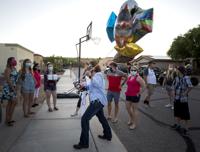
Michelle Leon Cordova, right, mother, brings celebration balloons to a car after staff members from Diamonds Children Center, friends and the Marana Police Department celebrate Sahuarita High School senior Lino Cordova, whom is fighting cancer, graduation with a car parade outside of his home on May 13, 2020 in Sahuarita, Ariz. Cordova stood on the sidewalk while the team from Diamond Children Center, friends and the Marana police department gave Cordova a graduation gar parade. Cordova was given a gift basket with his favorite snacks, gift cards as well as other items he enjoys. The car parade, also, celebrated another graduating senior fighting cancer from Empire High School, Noah Nieto. Nieto, also, received a gift basket with snacks, gift cards and other items Lino enjoys.
Tucson gets by during coronavirus pandemic
Updated
Personnel from Tucson Medical Center line the heliport to watch A-10's from Davis-Monthan Air Force Base's 355th Wing and F-16's from the Arizona Air National Guard's 162nd Wing make a pass over the facility, one leg of an area wide community flyover, May 14, 2020, Tucson, Ariz.
Tucson gets by during coronavirus pandemic
Updated
Nancy Celix-Campos, right, a respitory therapist at Tucson Medical Center, watches the military flyover with her daughters, Giana, 12, and Jazmyn, 8, from Sentinel Peak on May 14, 2020. Two F-16 Fighting Falcons from Arizona Air National GuardÕs 162nd Wing and two A-10 Thunderbolt II's from the 355th Wing, assigned to Davis-Monthan Air Force Base, fly over Tucson area hospitals to honor healthcare personnel and first responders as they are some of the frontline workers dealing with the coronavirus disease (COVID-19) head on. "It's been an exhausting two to three months," says Campos, "it's pretty cool, I like how they're going by each hospital."
Tucson gets by during coronavirus pandemic
Updated
Two F-16 Fighting Falcons from Arizona Air National Guard’s 162nd Wing and two A-10 Thunderbolt II's from the 355th Wing, assigned to Davis-Monthan Air Force Base, fly over Northwest Medical Center north of Tucson on May 14, 2020.
Tucson gets by during coronavirus pandemic
Updated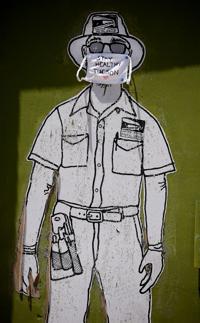
A letter carrier portrait on the Ok Market building, located in the Armory Park neighborhood, is adorned with a face mask on May 18, 2020.
Tucson gets by during coronavirus pandemic
Updated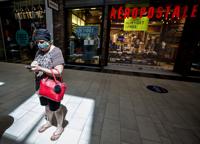
Rosemary Garcia waits for a family member outside of a store at Park Place Mall, 5870 E. Broadway Blvd., in Tucson, Ariz. on May 19, 2020. Malls reopened today under CDC guidelines and Gov. Ducey's new rules for businesses due to the Coronavirus pandemic. Park Place Mall has signs throughout the mall reminding customers to keep a six feet distance as well as hand sanitizer stations near each entrance. About half of the tables in the food court have been removed to allow for social distances as well as less than half of the stores have opened with new guidelines. Of the stores open, only 10 customers are allowed to shop in each store at a time.
Tucson gets by during coronavirus pandemic
Updated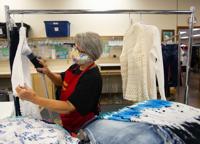
Pat Schlote steams clothing before it is put on the sales floor at the Golden Goose Thrift Shop in Catalina, Ariz., on May 21, 2020.
Tucson gets by during coronavirus pandemic
Updated
Ada Contreras, teaching assistant, looks through containers while reorganizing toys at Herencia Guadalupana Lab School, 6740 S. in Tucson, Ariz. on May 21, 2020. As Child care centers begin to re-open when they are ready, Herencia Guadalupana Lab School is reorganizing and cleaning everything in the facility before re-opening on June 2. To allow for social distancing and decrease the amount of items children touch, Herencia Guadalupana Lab School has sheds where items will go as well as placing items in containers organized by category.
Tucson gets by during coronavirus pandemic
Updated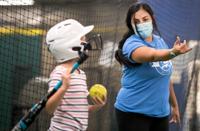
Jen Martinez, right, softball coach, teaches Skylar Reilly about hitting during a session at Centerfield Baseball Academy, 5120 S. Julian Dr., in Tucson, Ariz. on May 21, 2020. After re-opening on Monday, Centerfield Baseball Academy has implemented new policies in response to the Coronavirus Pandemic such as wearing masks, cleaning, signage, hand sanitizer and limiting the amount of people inside the facility.
Tucson gets by during coronavirus pandemic
Updated
Karl Bosma, left, and George Cantua, with facilities and maintenance, lay down stickers to mark six-foot separation distance around one of the baggage carousels, part of the efforts at Tucson International Airport to work within the restrictions of COVID19, May 22, 2020, Tucson, Ariz.
Tucson gets by during coronavirus pandemic
Updated
A lone passenger waits for a flight near one of the shuttered restaurants in the B Gates before Memorial Day at Tucson International Airport on May 22, 2020.
Tucson gets by during coronavirus pandemic
Updated
Drew Cooper on the stage in the St. Philip's Plaza courtyard, May 22, 2020, Tucson, Ariz., where live music is back on the schedule.
Tucson gets by during coronavirus pandemic
Updated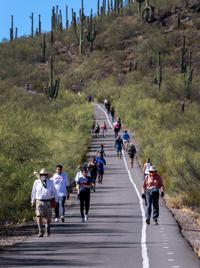
Many people visit Tumamoc Hill during the first day of Tumamoc's re-opening in Tucson, Ariz. on May 25, 2020. After being closed due to the Coronavirus pandemic, Tumamoc Hill re-opened with some modifications. There are hand sanitizer stations throughout the hike to the top as well as arrows, spaced 10-ft apart, lined up and down the hill. Some runners, hikers and walkers are also wearing masks during their hike. "The steps we are taking aim to provide our community with needed exercise, connection to our beautiful desert and a sense of comfort in such a trying time, while balancing the fact that gathering as a community endangers each of us and our loved ones. This is an unprecedented challenge that we are taking extremely seriously," said Benjamin T. Wilder, director of Tumamoc Hill. Visitors are also asked to limit their group to three people and to not touch the gate at the top of the hill- a tradition for some who make it to the top. "This is a time when we need to establish new traditions and adapt in a creative manner that embraces empathy, unity, care and patience," Wilder said.
Tucson gets by during coronavirus pandemic
Updated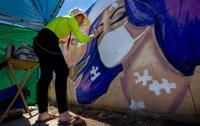
Pen Macias, artist, works on part 2 of a mural for a client on E. Broadway Rd., between S. Columbus Blvd. and S. Alvernon Way, in Tucson, Ariz. on May 25, 2020. Macias, known as The Desert Pen, has been working on her clients mural for the past three months. "It's the one thing I love, I have a passion for and the only thing I could be happy doing," said Macias. The mural represents her client, a single mother of four who works in the health care field. One half of the mural is dedicated to the connection between mothers and their children. The other half is dedicated to the connection between nurses and patients. The client wanted some positivity in the mural to show how nurses give a piece of themselves to their patients hence the puzzle pieces in the nurse and the patients, said Macias.
Tucson gets by during coronavirus pandemic
Updated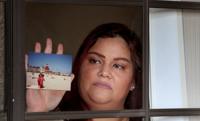
Christina Cortinas, posing at her home, May 28, 2020, Tucson, Ariz., with a photo of her and her mother, Catherine Rodriguez, in San Diego, 1991. Rodriguez is currently in assisted living and fighting COVID19. Cortinas hasn't seen her mother in months, the longest such span in her life.
Tucson gets by during coronavirus pandemic
Updated
Ruben Lopez looks through handouts while attending a Eviction Resource Fair with his family outside the Pima County Justice Court.




